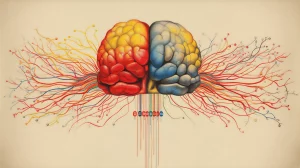Discover the science behind Galvanic Skin Response (GSR), a key tool for measuring emotional and physiological reactions. Explore how GSR works, its use in research, and its applications in areas like psychology, usability testing, and biometrics. Perfect for researchers seeking to uncover deeper insights into human behavior.
Table of Contents
- What is Galvanic Skin Response (GSR) and Why Does It Matter?
- How Does Galvanic Skin Response (GSR) Work in Measuring Emotions?
- Emotional sweating?
- GSR & emotional arousal
- Top Applications of Galvanic Skin Response in Research and Industry
- GSR Sensors
- GSR Devices
- Setting it up
- GSR reloaded: Adding more biosensors
- Frequently asked questions
- Free 36-page EDA/GSR Guide
- References
What is Galvanic Skin Response (GSR) and Why Does It Matter?
The skin tells everything – our skin gives away a lot of information on how we feel when we’re exposed to emotionally loaded images, videos, events, or other kinds of stimuli – both positive and negative. No matter whether we are stressed, nervous, fearful, psyched up, stoked, baffled, or surprised – whenever we are emotionally aroused, the electrical conductivity of our skin subtly changes.
One of the most sensitive measures for emotional arousal is Galvanic Skin Response (GSR), also referred to as Electrodermal Activity (EDA) or Skin Conductance (SC).
Galvanic Skin Response originates from the autonomic activation of sweat glands in the skin. The sweating on hands and feet is triggered by emotional stimulation: Whenever we are emotionally aroused, the GSR data shows distinctive patterns that are visible with bare eyes and that can be quantified statistically.

What makes GSR such a valuable biometric signal in assessing emotional behavior?
With GSR, you can tap into unconscious behavior that is not under cognitive control. Skin conductivity is solely modulated by autonomic sympathetic activity that drives bodily processes, cognitive and emotional states as well as cognition on an entirely subconscious level. Exactly this circumstance renders GSR the perfect marker for emotional arousal as it offers undiluted insights into physiological and psychological processes of a person.
N.B. this post is an excerpt from our Galvanic Skin Response Pocket Guide. You can download your free copy below and get even more insights into the world of Galvanic Skin Response. Scroll to the bottom of the page for your free download.
How Does Galvanic Skin Response (GSR) Work in Measuring Emotions?
To understand how GSR works, take a quick step back and have a look at the physiological characteristics of the largest organ of the human body – the skin.
Our skin functions as the principal interface between organism and environment. Together with other organs, it is responsible for bodily processes such as the immune system, thermo-regulation, and sensory-motor exploration:
1. Immune System
As a protective barrier, the skin separates our body from the environment and its threats – mechanical impacts and pressure, variations in temperature, micro-organisms, radiation, and chemical agents.
2. (Thermo-)Regulation
The skin controls body temperature by regulating sweat emission, piloerection (“goosebumps”), and peripheral blood circulation.
3. Sensing and Perception
The skin is an organ of perception. It contains an extensive network of nerve cells that detect and relay changes in the environment based on the activity of receptors for temperature, pressure, and pain.
Consistent with this complexity of function, the skin has three primary layers:
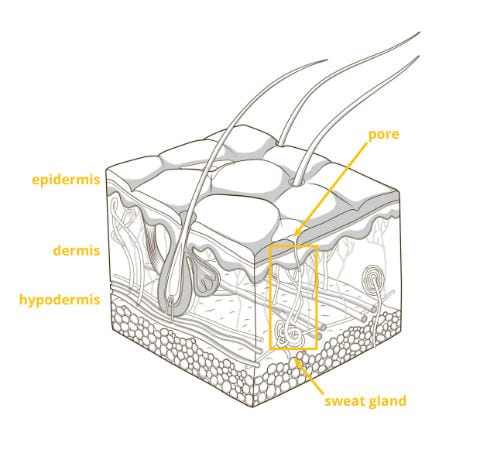
- Epidermis
(outmost protective layer) - Dermis
(cushion for the body from stress and strain) - Hypodermis
(anchor to bones and muscles)
Our body has about three million sweat glands. The density of sweat glands varies markedly across the body, being highest on the forehead and cheeks, the palms and fingers as well as on the sole of the feet.
Whenever sweat glands are triggered and become more active, they secrete moisture through pores towards the skin surface. By changing the balance of positive and negative ions in the secreted fluid, electrical current flows more readily, resulting in measurable changes in skin conductance (increased skin conductance = decreased skin resistance).
This change in skin conductance is generally termed Galvanic Skin Response (GSR).
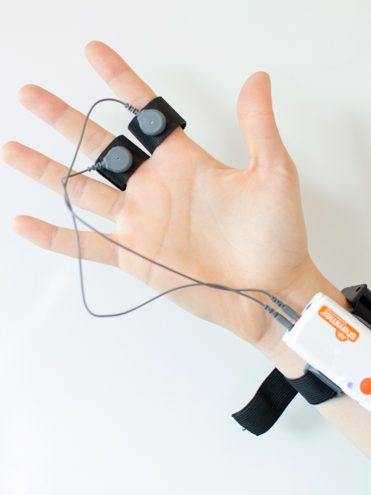
Galvanic Skin Response (GSR)
Galvanic Skin Response reflects the variation in the electrical characteristics of the skin.
GSR is also known as Skin Conductance (SC), Electrodermal Activity (EDA), Electrodermal Response (EDR) and Psychogalvanic Reflex (PGR)
GSR activity is typically measured in “micro-Siemens (uS)” or “micro-Mho (uM)”, mirroring the conductance of a certain material.
While the primary purposes of sweat emission are thermoregulation and evaporative cooling, sweating on hands and feet is also triggered whenever we’re emotionally aroused.
Emotional sweating?
Yes, you heard right. Let’s explain.
Like other vegetative auto-regulatory processes (body temperature, heart rate, blood pressure, gut motility etc.) sweat secretion cannot be controlled consciously. Rather, it is driven and balanced by our autonomic nervous system in order to meet behavioral demands (to prepare and execute energetic movement, for example).
Most broadly, the autonomic nervous system can be separated into the following two “subdivisions”:
The sympathetic nervous system
represents a rapid response mobilizing system, facilitating immediate motor action (“fight or flight”). Increased sympathetic activity is associated with bodily indicators of “autonomic arousal” such as increased heart rate, blood pressure, and sweating.
The parasympathetic nervous system
regulates slowly changing processes associated with „resting and digesting“ or „feeding and breeding“.
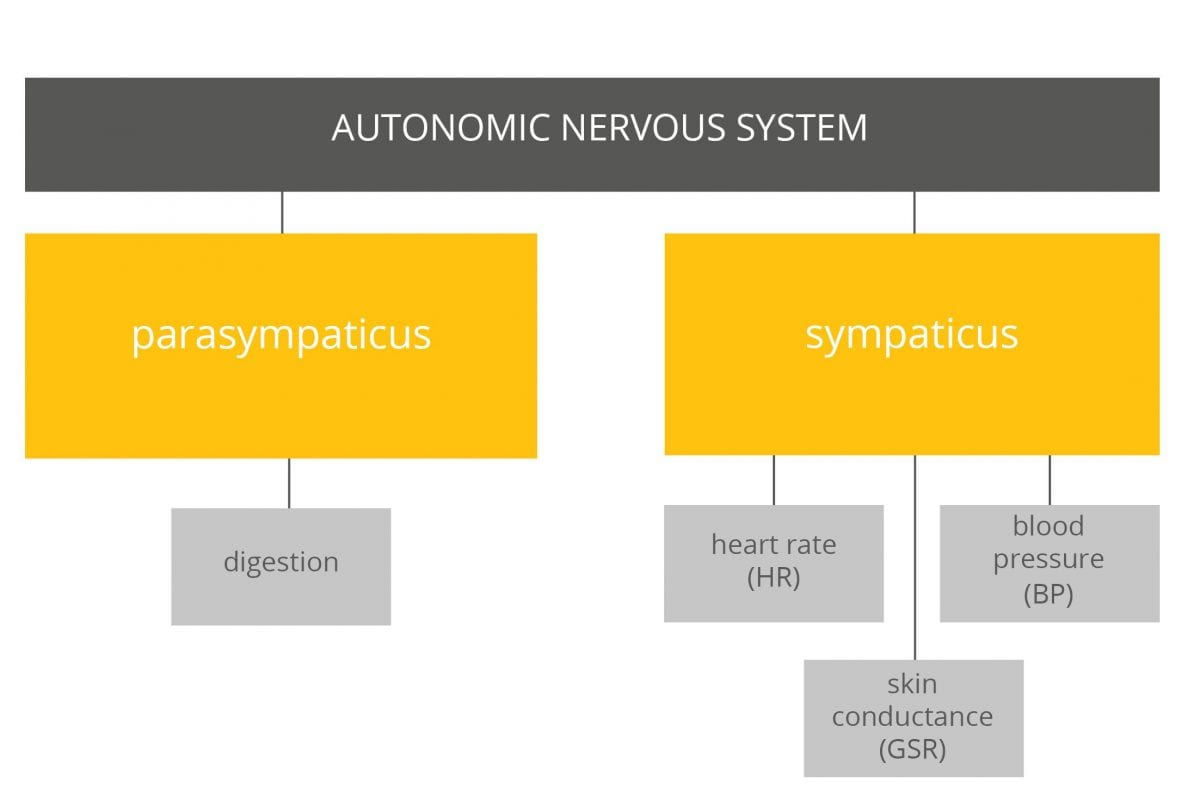
Let’s recap!
Sweat secretion and the associated changes in skin conductance are nonconscious processes that are solely under sympathetic control and reflect changes in arousal.
GSR & emotional arousal
So far, so good: Emotional experiences trigger changes in autonomic arousal quite impressively. Now what does that mean exactly?
Exposure to fear-inducing stimuli (an angry face, the sight of a creepy spider etc.) induce emotional arousal, causing an increase in sweat secretion and, ultimately, measurable electrodermal activity.
In emotional situations, bodily processes are triggered automatically: The heart beats faster, the pulse rises, hands become sweaty. To put it bluntly: While we are physiologically or psychologically aroused (in fear, extreme joy or under stress), we start to sweat.
In case you were thinking sweat running down in streams, let‘s give the all-clear here: Actually, we don‘t need to be sweat-flooded in order to see differences in electrodermal activity (in fact, the sweating doesn’t even need to be visible).
Besides emotional stimulus properties, recent findings indicate that skin conductance is also sensitive towards other aspects of a stimulus.
Are we familiar with the stimulus or do we encounter it for the first time? Is the stimulus threatening or rewarding? Do we associate the stimulus with wins or losses, love or hate, anticipation and outcome, memory recall or cognitive work? Against this backdrop, changes in skin conductance might also reflect motivational and attentional processing.
Top Applications of Galvanic Skin Response in Research and Industry
“By 1972, more than 1,500 articles on GSR had been published in professional publications, and nowadays GSR is regarded as the most popular method for investigating human psychophysiological phenomena.” Boucsein (2014)
With GSR, the impact of any emotionally arousing content, product or service can be tested – actual physical objects, videos, images, sounds, odors, food probes and other sensory stimuli as well as thought experiments and mental images.
Paired with the fact that GSR responses are extremely easy to measure, possible applications cover a fascinating variety of fields in academic and commercial research.
Psychological Research
Psychological studies utilize Galvanic Skin Response to identify how humans respond emotionally towards various stimuli and how these responses are affected by stimulus properties (color, shape, duration of presentation), personality characteristics (extraverts vs. introverts), social expectancies (“men are not afraid of the dark!”), and the interaction of cultural aspects and individual learning histories. Think of this: A terrifying encounter with the neighbor’s vicious dog in your childhood certainly triggers autonomous arousal and increased sweating when you come face to face with dogs in later life (perhaps even an image of a dog is enough to give you the creeps).
Clinical Research & Psychotherapy
Clinical populations such as patients suffering from eating disorders, phobias or post-traumatic stress syndrome (PTSD) show heightened fear responses and emotional arousal to trauma reminders. Also, autonomous responses towards threatening stimuli typically do not subside even in the presence of safety reminders. Over the course of a cognitive-behavioral therapy, however, GSR can be monitored during exposition or relaxation trainings in order to provide a quantitative measure of the physiological arousal of the patient and assess the severity of the disease as well as the success of the therapeutic intervention.
Consumer Neuroscience & Marketing
Evaluating consumer preferences is a critical element of marketing. GSR can be measured to track emotional arousal towards products with high consumer interest, however only subtle differences in terms of performance and quality. For example, shopping preferences and decisions in cosmetics are primarily based on affective and sub-conscious processes. With the help of Galvanic Skin Response recordings exactly these processes can be examined in more detail in order to enhance products, assess market segments or identify target audiences and personas.
Media & Ad Testing
In media research, campaign material such as TV ads, trailers, and full-length shows can be shown to individual participants or focus groups while monitoring their emotional arousal based on Galvanic Skin Response measurements. Identifying key frames in the stimulus material or isolating scenes that “just don’t work” (where supposedly emotional content was shown but the audience did not respond) are just two of the many approaches to utilizing GSR for evaluation purposes.
Usability Testing & UX Design
Using software should be a pleasant experience. Hence, frustration and confusion levels should certainly be kept as low as possible. Monitoring GSR can provide unfiltered insights into stress levels of users during the interaction with new website content, user interfaces, and online forms. How emotionally satisfying is the navigation? Whenever visitors encounter road blocks or get lost in complex sub-menus, you might certainly see increased stress levels reflected in stereotypic GSR activation patterns.
GSR Sensors
Let‘s get practical with some good news: The observation of electrodermal phenomena requires only very basic equipment. However, there are a few things to keep in mind when it comes to choosing the right gear and applying it correctly.
Need of Galvanic Skin Response Sensor
With minimal preparation times and cleanup, skin conductivity is recorded non-invasively using two electrodes placed on the skin. This renders GSR measurements a lot more comfortable for respondents compared to other neuro-methods such as fMRI or EEG, where longer preparation and calibration phases are quite common (and sometimes a true hassle).
Generally, GSR sensors have a 1 cm² measurement site made of Ag/AgCl (silver/silver-chloride) and are placed either in reusable snap-on Velcro straps or in a patch sticker. While the former can be applied as-is, the patch sticker requires to use conductive gel in order to improve the conductivity between skin and electrode.
Logic Behind GSR Sensors

- Place two electrodes on emotionally sensitive locations on the body
- Apply a low constant voltage
- Measure the voltage difference between the two electrodes
- Report the associated skin conductance

What about the sampling rate?
Although GSR data might be acquired with arbitrary sampling rates (up 2000 Hz), already very low sampling rates are sufficient.
We suggest sampling rates from 1 or 10 Hz, however keep in mind that higher sampling rates might be necessary if the same device collects GSR and other physiological parameters such as (optical) heart rate, for example.
GSR Devices
In case you are thinking bulky equipment, think again. In fact, GSR devices are quite the opposite.
They typically consist of two electrodes, an amplifier (to boost signal amplitude), and a digitizer (to transfer the analog raw signal into binary data streams). Wireless GSR devices further contain data transmission modules for communication with the recording computer (using the Bluetooth protocol, for example). Principally, GSR devices offer different sensor placement options. While some devices allow arbitrary sensor placements in any of the locations we have already mentioned, other devices have GSR electrodes rigidly mounted in wristbands or elastic straps.
There is no “one fits all” solution – it very much depends on your research question and the specific requirements of your study which sensor to pick in order to obtain the most appropriate GSR data.
However, irrespective of which GSR sensor you go for, it is always good advice to assess the quality of the GSR signal in the live viewer before you start the recording.
You can even examine the data together with the respondent in order to check for potential issues and visualize the impact of breathing, movements, and talking.
Setting it up
Here’s our handy checklist for the rather technical aspects of data collection:
1. Have you attached the GSR electrodes?
Make sure that the sensors are properly attached to the fingers, hand or foot.
2. Have you wired up all cables correctly?
Check if the electrode cables are not dangling loosely but are properly plugged into the correct sockets of your GSR device.
3. Is the GSR device up and running?
You don’t believe how many experiments have been started with the GSR sensors still turned off. Spare yourself the hassle and make sure that the device is set to “on” and configured correctly.
4. Is the GSR device properly connected?
GSR devices are either plugged in directly or are connected wirelessly, so always test if the connection has been established. Check if the Bluetooth dongle is properly plugged in and receives incoming data. As Bluetooth technology is a short-range wireless connection between two devices, take care of the following:
- Reception range
Even if the transmitting GSR device and the Bluetooth receiver are in direct line of sight, try to stay in the recommended reception range (approximately 5 meters) as the connection is lost otherwise. - Obstruction
Bluetooth signals cannot pass through water, human tissue or concrete. This implies that the connection is dropped whenever respondents walk into neighboring rooms or occlude the sensor with their hand or body (we actually consist to 80% of water).
GSR reloaded: Adding more biosensors
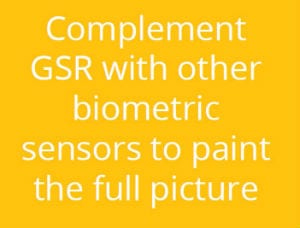
What we know so far: Skin conductance offers tremendously valuable insights into our subconscious arousal when we‘re confronted with emotionally loaded stimulus material.
However, solely based on GSR we can‘t extract whether the arousal was due to positive or negative stimulus content. Why? The GSR peaks look completely identical. Both positive and negative stimuli can result in an increase in arousal triggering GSR peaks.
In other words: While GSR is an ideal measure to track emotional arousal, it is not able to reveal the emotional valence, that is, the quality of the emotions. The true power of GSR unfolds as it is combined with other sources of data to measure complex dependent variables and paint the full picure of emotional behavior.
The following 5 biosensors are a perfect complement to GSR recordings. Which metrics can be extracted from the different systems?
Let‘s see.
Eye tracking
Eye tracking implies the recording of eye position (gaze point) and movement on a 2D screen or in 3D environments based on the optical tracking of corneal reflections. Eye tracking reflects visual attention as it objectively monitors where, when, and what respondents look at. Further, eye tracking devices report the dilation and constriction of the pupil, which has been found to correlate with emotional arousal and cognitive workload. Eye tracking therefore can be used to validate and compliment GSR measurements.
Facial expression analysis
Facial expression analysis is a non-intrusive method to assess both emotions (subtle movements in face muscles, mostly subconscious) and feelings (accompanied by clearly noticeable changes in facial expression). While facial expressions can measure the valence of an emotion/feeling, they can’t measure the associated arousal.
EEG
Electroencephalography is a neuroimaging technique measuring electrical activity on the scalp. EEG tells which parts of the brain are active during task performance or stimulus exposure. Analyze brain dynamics of engagement (arousal), motivation, frustration, cognitive workload and other metrics associated with stimulus processing, action preparation, and execution. EEG usually tracks stimulus-related processes much faster compared to other biosensors.
EMG
Electromyographic sensors monitor the electric energy generated by bodily movements (e.g., of the face, hands or fingers). Use EMG to monitor muscular responses to any type of stimulus material to extract even subtle activation patterns associated with consciously controlled hand/finger movements (startle reflex). Also, facial EMG can be used to track smiles and frowns in order to infer one’s emotional valence.

The whole is more than the sum of its parts
Each biometric sensor reveals a specific aspect of human cognition emotion and behavior.
Depending on your individual research question, consider to combine GSR with two or more additional biosensors in order to gain meaningful insights into the intricate relationships between the autonomic regulation of emotional arousal and valence, cognition, attention and motivation.
N.B. This is an excerpt from our free guide “GSR – The Complete Pocket Guide”. To get the full guide, follow the link below.
Frequently asked questions
Can GSR sensors be integrated with other devices or software?
Yes, GSR sensors can be integrated with various devices and software, often used alongside other biometric measurements for comprehensive analyses.
What are the components of a GSR sensor?
The primary components of a GSR sensor include electrodes (typically made of silver or silver-chloride) for detecting skin conductance changes and wires or connections that relay this data to a data acquisition device.
Can Galvanic Skin Response equipment be used for biofeedback therapy?
Yes, Galvanic Skin Response equipment can be employed in biofeedback therapy to help individuals understand and control their physiological responses to stress or stimuli.
Free 36-page EDA/GSR Guide
For Beginners and Intermediates
- Get a thorough understanding of all aspects
- Valuable GSR research insights
- Learn how to take your research to the next level

References
Bakker, J., Pechenizkiy, M., & Sidorova, N. (2011). What’s your current stress level? Detection of stress patterns from GSR sensor data. In Proceedings – IEEE International Conference on Data Mining, ICDM (pp. 573–580).
Benedek, M., & Kaernbach, C. (2010). Decomposition of skin conductance data by means of nonnegative deconvolution. Psychophysiology, 47, 647–658.
Benedek, M., & Kaernbach, C. (2010). A continuous measure of phasic electrodermal activity. Journal of Neuroscience Methods, 190, 80–91.
Boucsein, W. (2012). Electrodermal activity. Techniques in psychophysiology (Vol. 3).
Boucsein, W., Fowles, D. C., Grimnes, S., Ben-Shakhar, G., Roth, W. T., Dawson, M. E., & Filion, D. L. (2012). Publication recommendations for electrodermal measurements. Psychophysiology, 49(8), 1017–1034.
Critchley, H. D. (2002). Electrodermal responses: what happens in the brain. The Neuroscientist : A Review Journal Bringing Neurobiology, Neurology and Psychiatry, 8(2), 132–142.
Dawson, M. E., Schell, A. M., and Filion, D. L. The electrodermal system. In J. T. Cacioppo, L. G. Tassinary, and G.B. Bernston, editors, Handbook of Psychophysiology: second edition, pages 200–223. Cambridge Press, Cambridge, 2000.
Gravenhorst, F., Muaremi, A., Tröster, G., Arnrich, B., & Gruenerbl, A. (2013). Towards a Mobile Galvanic Skin Response Measurement System for Mentally Disordered Patients. In Proceedings of the 8th International Conference on Body Area Networks (pp. 432–435).
Groeppel-Klein, A. (2005). Arousal and consumer in-store behavior. Brain Research Bulletin, 67(5), 428–37.
Guo, R., Li, S., He, L., Gao, W., Qi, H., & Owens, G. (2013). Pervasive and Unobtrusive Emotion Sensing for Human Mental Health. Proceedings of the ICTs for Improving Patients Rehabilitation Research Techniques, 436–439.
Reinhardt, T., Schmahl, C., Wüst, S., & Bohus, M. (2012). Salivary cortisol, heart rate, electrodermal activity and subjective stress responses to the Mannheim Multicomponent Stress Test (MMST). Psychiatry Research, 198(1), 106–111.
Roy, J.-C., Sequeira-Martinho, H., & Delerm, B. (1993). Neural control of electrodermal activity: Spinal and reticular mechanisms. In Roy, Jean-Claude; Boucsein, Wolfram; Fowles, Don C.; Gruzelier, John H (p. (1993). Progress in electrodermal research. NATO A).
Tyler, W. J., Boasso, A. M., Charlesworth, J. D., Marlin, M. A., Aebersold, K., Aven, L. et al. (2015). Transdermal neuromodulation of noradrenergic activity suppresses psychophysiological and biochemical stress responses in humans.






